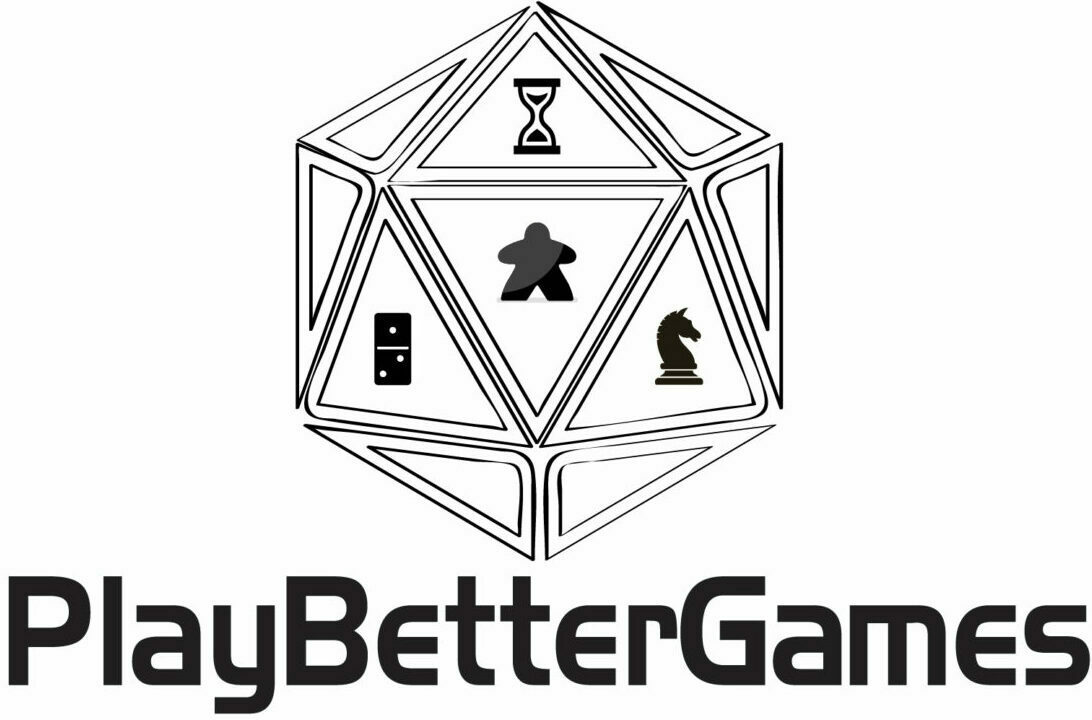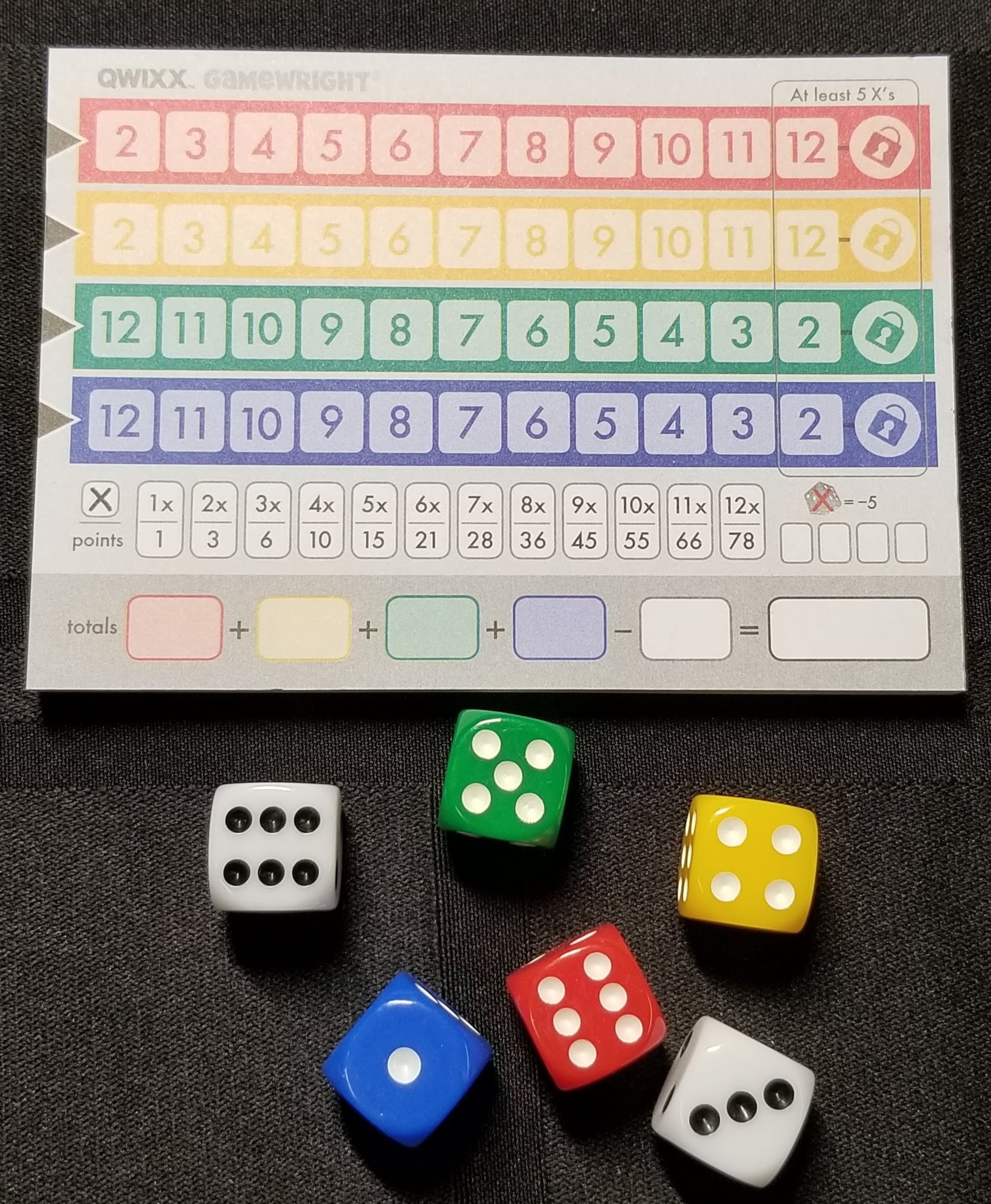Roll and write games are a type of board game in which players roll dice and use the results to fill in predefined spaces on their individual game boards. Often these boards are simply a preprinted sheet of paper. The first player to complete their board (or to finish with the highest score) wins the game.
Roll and write games are easy to learn and can be played by people of all ages. Some of them accommodate high player counts making them great games for large groups. In this post, we will discuss Roll and Write games and suggest some great options you can try if you want to sample the genre.
Classic Roll and Write Games
One Roll and Write game that most people are familiar with is Yahtzee. In Yahtzee, players each have their own scoring sheet that contains 13 possible dice combinations that score points. Many of us spent many a game night rolling dice with the family playing this game.
If you’re unfamiliar with Yahtzee, to begin the game, each player rolls all five dice. The player with the highest total starts the game and play then proceeds clockwise around the table.
On each turn, the active player rolls the dice up to three times in an attempt to make one of the thirteen possible scoring combinations. After each roll, the player may choose to score the current roll, save any of the dice as keepers or re-roll any or all of the dice.
At the end of three rolls the player must score the dice, if they can not score in any of the categories they must choose one of the categories for which to take zero points. Once a combination has been scored, it cannot be scoring again in that particular game. The game ends once all 13 combinations have been scored.
The player with the highest total score at the end wins the game!
How Roll and Write Games Have Improved
Roll and write games have come a long way since Yahtzee. In recent years, there has been an explosion of new games entering the genre and many have added new mechanics and features that make them even more fun to play.
If you like Yahtzee you should check out some of the modern Roll and Write games!
Roll and write games have also inspired a sub-genre often called “Flip and Write” which share most of the same mechanics, but use cards instead of dice to drive the game forward.
Pros and Cons of Roll and Write Games
The good
- Roll and write are easy to teach and quick to play
- Most people will enjoy them
- They are great games for larger groups because they typically accommodate high player counts.
- They have a small footprint and are great to take with you when traveling
- They are generally rather inexpensive
The Bad
- Roll and write games can be a bit repetitive.
- With everyone working on their own board, sometimes there is not a lot of player interaction.
- They usually are pretty lacking in terms of theme
- They are finite because they rely on sheets of paper that are consumed during play, but many are starting to offer erasable boards and replacement pads.
Roll (Flip) and Write Games you Should Try
There are literally hundreds of games in the Roll and Write category now. If you like Yahtzee, or think you would like Yahtzee if it were a little more complex, I suggest you give these games a try.
Qwixx
In Qwixx, players are trying to score as many points as possible by marking off numbers on their score sheet. The score sheet contains four rows of numbers each of a different color, two rows are numbered from 2-12 and two from 12-2.
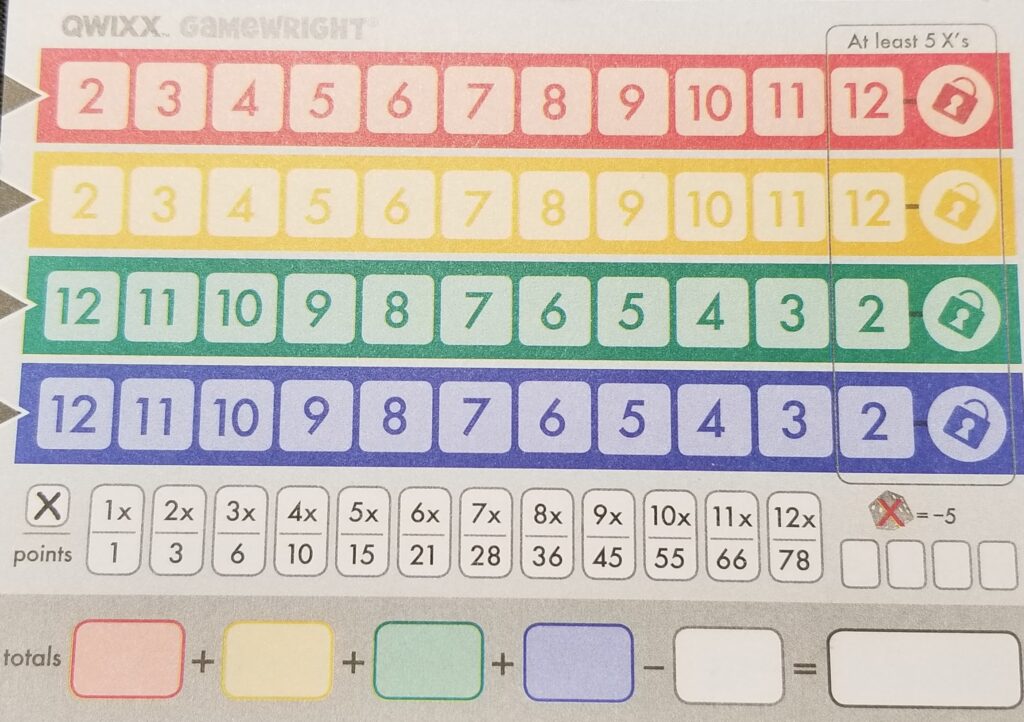
On a turn, the active player rolls two white dice and one dice of each row color. The player whose turn it is can take the sum of one of the white dice and one of the colored dice and mark that number off in that color row.
The non-active players can take the sum of the two white dice and mark that number off in any of the colored rows. This is optional, you don’t have to do this. Players must be careful because once you’ve marked off a number you are no longer allowed to mark off any of the numbers to the left of it!
Players score points based on the number of spaces they can mark off in each row. Once a player gets five in one color that color is “locked” and no one can mark spaces of that color going forward. Once two rows are locked, the game ends.
This is a great roll and write because it keeps players engaged even when it’s not their turn, it’s definitely worth checking out. You can usually find it for under $8.
Twice as Clever
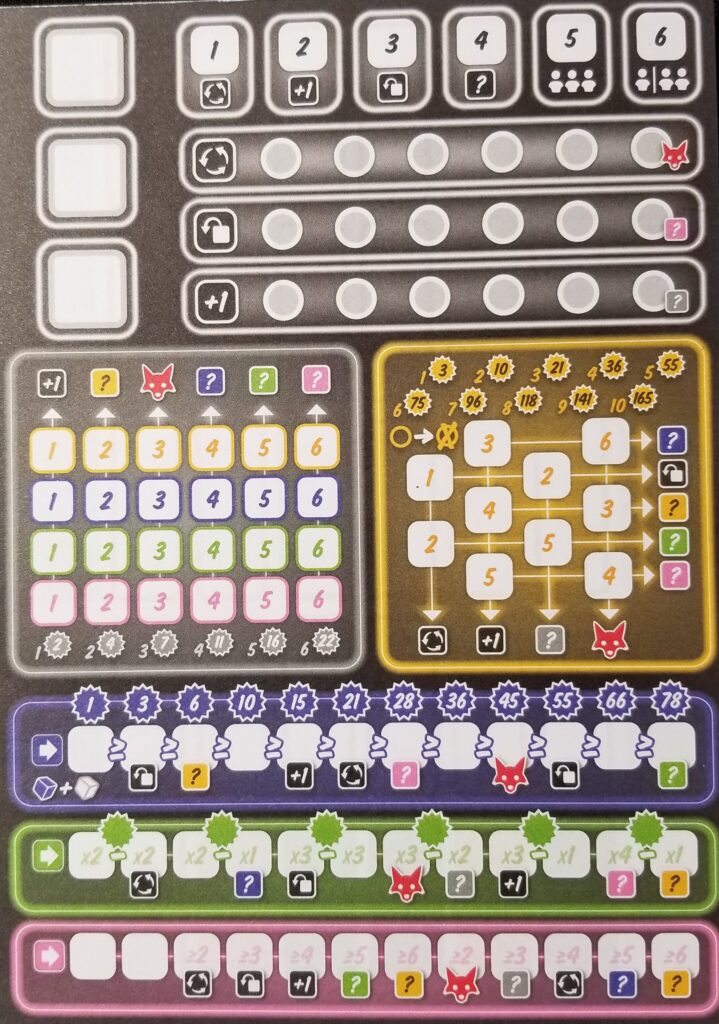
Twice as Clever is another great game that keeps players engaged on every turn. The scoring is more complicated than Qwixx, so you may want to play a couple of roll and writes before trying this one. To see what I mean – here is the score sheet for Twice as Clever
In this game, the active player rolls six different colored dice and chooses one of them to score. Every dice that has a value below the die chosen become available for other players to use. Every dice left can be re-rolled and the player can make an additional selection (up to three).
In Twice as Clever you have to strike a balance between taking a high-value die and taking more dice. There are also a lot of scoring options that interact with each other, so if you’re “clever” you can set off a chain that gets you a lot of points.
There are three version of this game, the first one is getting kind of hard to find, but Twice as Clever and Clever Cubed are both still widely available. I’ll do a full write-up on this game soon and go into all the details, but if you haven’t played this one, you really need to try it.
Rolling America
Rolling America is more of a puzzle than a point-scoring game. Picture a map of the United States with the map divided into six sections, each a different color. There is a dice of each color and a clear die that is wild.
All seven dice are placed in a bag, drawn out in pairs, and rolled. Each player must then resolve both dice and place the number rolled in a State of the matching color. Since the dice are drawn in pairs, in each round there will be one dice that is not chosen.
Neighboring states can not have numbers next to them with a difference of more than one (there’s the puzzle). If a player can not legally place the number, they must choose a state of that color to place an X in.
There are a limited number of times you’re allowed to break the rules and there are boxes you mark off when this is done. After 8 rounds the player with the fewest number of X’s wins the game! This is one where the theme is pretty light, but it’s a great option if you don’t want to spend a lot of time adding up scores. Rolling America can usually be found for $10 – $15. You should definitely consider picking up a copy if you think you’d like a light, puzzle-type roll and write at your table.
Welcome To
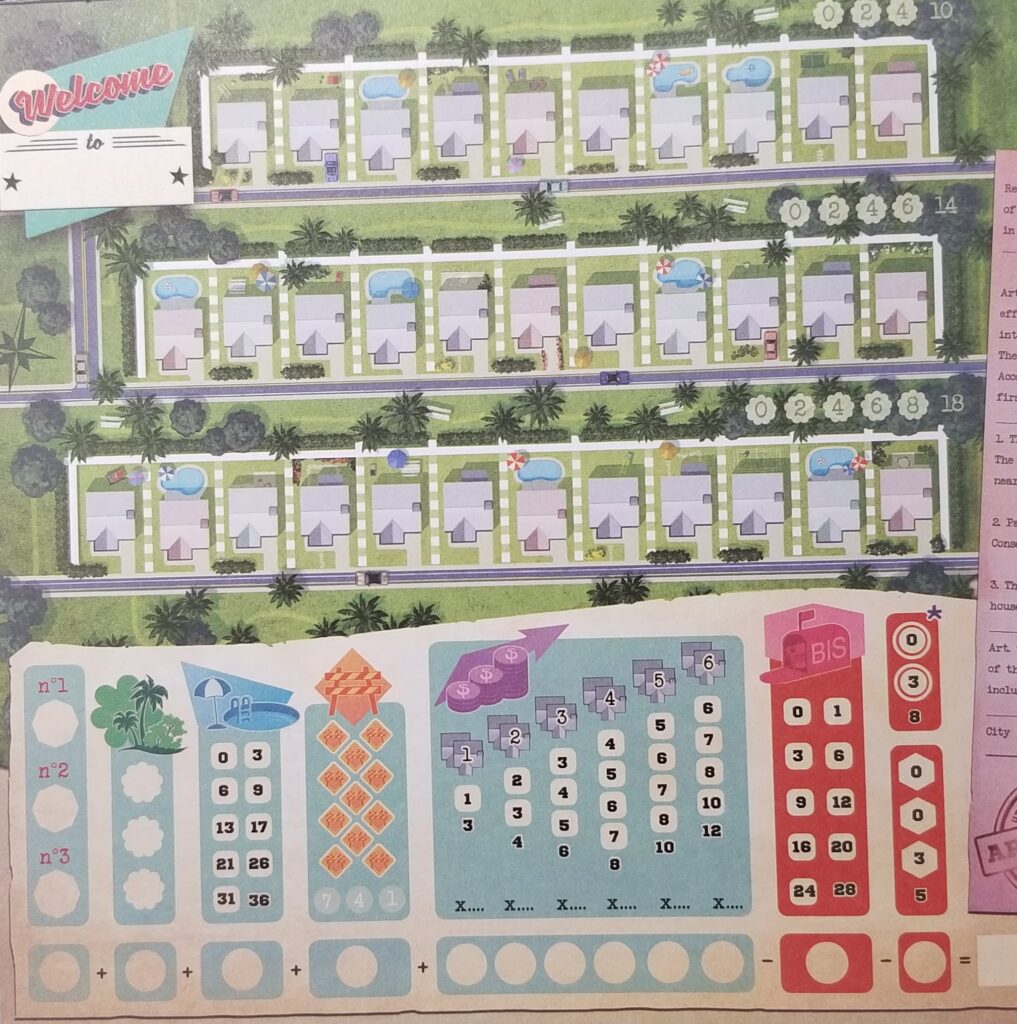
Welcome to is the only “Flip and Write” on this list. It’s another one that can seem a little complicated at first, but once you’ve played it through once it will be much easier. The game comes with a player aid that helps you remember all of the rules and scoring, don’t forget to pass those out. The last time I played with with new people I forgot about this, the game would have gone much smoother if I had remembered.
In this game players are trying build the best neighborhood they can. All players start with the same neighborhood on their player board.
Each house on the streets signifies lots where a house can be built, as you can see some lots are planned to have pools. Also there are white dotted lines where you can build fences, and the circles containing numbers above each street are there to represent the number of parks each street has.
Throughout the game players are offered a choice of three potential house numbers and actions determined by three decks of cards.
The players must choose one of the pairs of card (ie 13 and Bis, 9 and fence, 7 and park in the above example). Once they’ve chosen they must build a house by placing that house number on one of their streets (numbers must increase going left to right) and they can take the action (add a fence, a park, a pool etc).

In most cases you must take the action at the same house/street where you place the number (the exception being fences) So if your pair has a pool you’ll want to place that number on a lot that has a pool planned in order to be able to score the pool.
As you can see there is a lot think about, but that’s part of what makes the game interesting. I’ll make a full post on this game for those who are interested in learning more but it’s one that is really best to play. I keep this game on the shelf because it’s a good party game, it can literally accommodate any number of players but it’s able to scale in this way because there is no real player interaction.
It’s very much like having ten people play the same game together, separately. There are some “city planning” goals that you are racing to complete before the other players (the first person to do it gets more points) but that’s really all there is in terms of interaction.
That said, it’s interesting to see how different all of the neighborhoods end up when everyone was given the same starting layout and the same set of choices.
If you really like the game they now also make dry-erase boards as an add-on.
Final Thoughts
This is by no means an exhaustive list, there are a lot of great roll and write games not mentioned here, and they’ll be getting their own posts over time, but these are some great options if you want to experience more of what this genre has to offer.
I like to have this style of game on the shelf because they are something different, they are quick, and some of them are a blast to play. I hope this post has given you some ideas and inspired you to try one of these great games!
